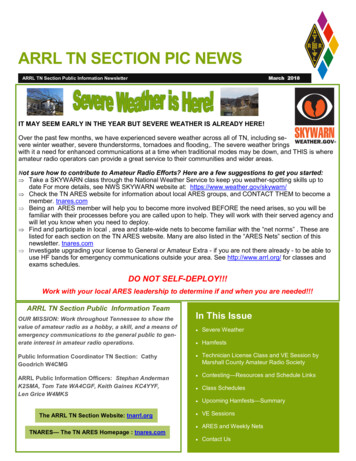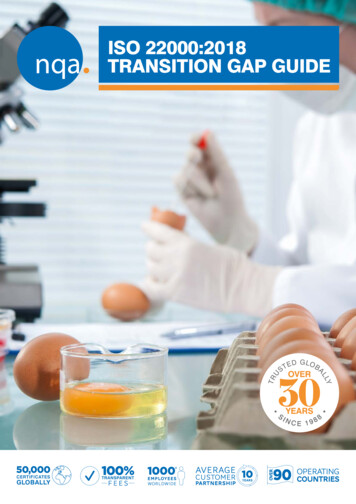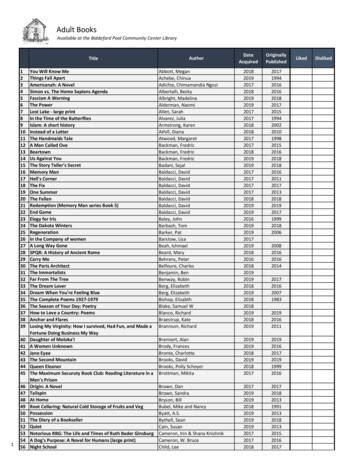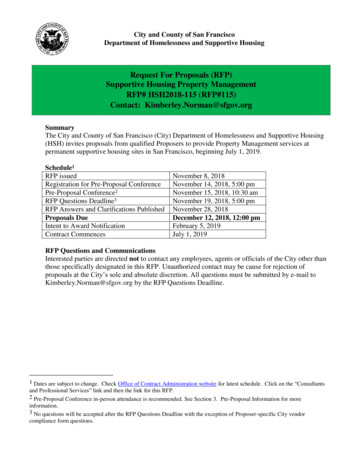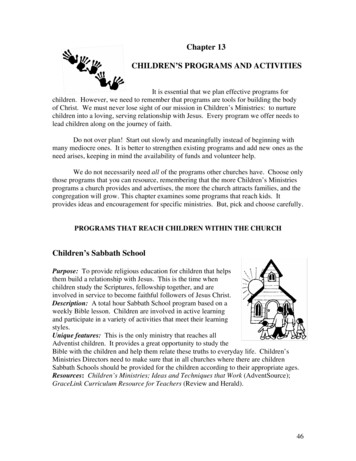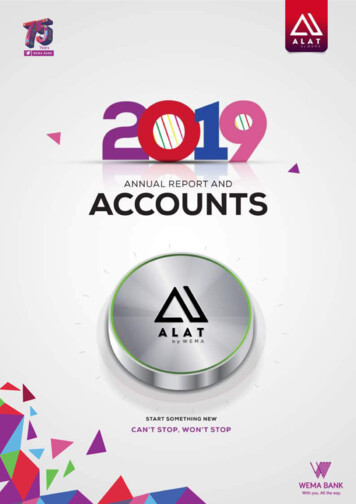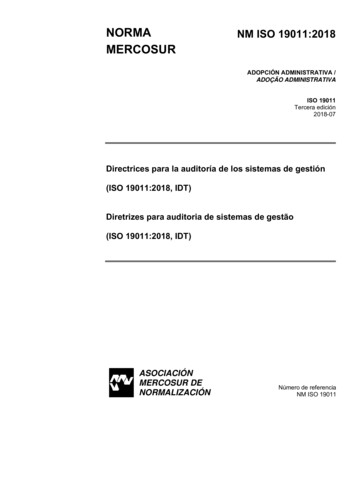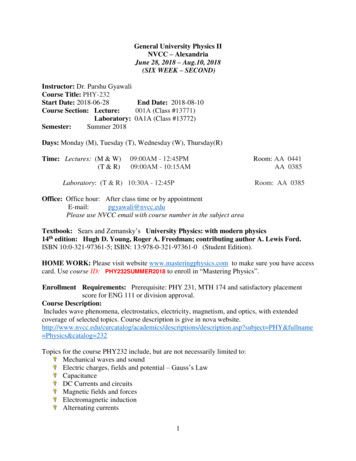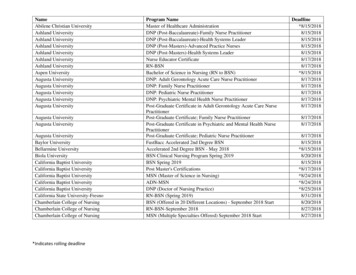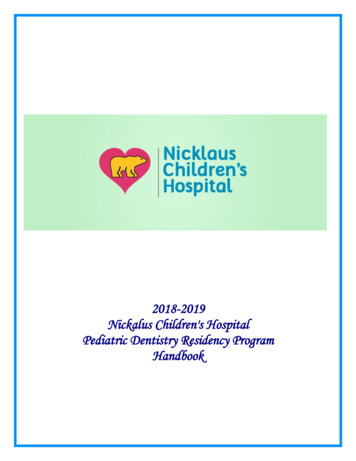
Transcription
2018-2019Nickalus Children's HospitalPediatric Dentistry Residency ProgramHandbook
Pediatric DentistryDear Resident:Welcome to Nicklaus Children’s Hospital Pediatric Dentistry Residency TrainingProgram. This syllabus contains descriptions of all facets of the ResidencyProgram. You should read this syllabus and discuss with the Pediatric DentistryResidency Director or any Dental attending.We are looking forward to working with you during the next two years as youacquire the necessary training to become a practicing Pediatric Dentist. We feelthat we have an excellent program, and we welcome the opportunity to work withyou.Sincerely Yours,Rosie Roldan, DMD,MDPediatric Dentistry Residency Director2
TABLE OF CONTENTSI. PROGRAM DESCRIPTION .6II. OVERALL CURRICULAR OBJECTIVES .6III. CLINICAL ROTATIONS CURRICULUM .8 Pediatric Dental Clinic .8 Oral Surgery . .9 Operating Room and Sedation .9IV. DIDACTIC CURRICULUM BASIC SCIENCE SYLLABUS .11-Courses: Basic pediatric Dentistry Core .11 Orthodontic Core .12 Child Development and Behavior Management .14 Sedation in Pediatric Dentistry.16 Craniofacial Growth and Development .17 Cariology and Preventive Dentistry.18 Hospital Dentistry .19 Oral Pathology.21 Special Patient Care .22 Practice Management and Ethics .24 Dental Pharmacology .25 Dental Literature Review .26 Advanced pediatric Dentistry Core .28-Pediatric Dentistry Off-Service Rotation: Pediatric Anesthesiology Rotation .29 Pediatric Medicine Rotation .31 Pediatric Operating Room Rotation .33 Inpatient Care Rotation .35 Genetics and Craniofacial Rotation .37- Multidisciplinary Presentations Syllabus .39- Case Presentations Syllabus .39- Chart Review Syllabus .40- Conference Syllabus .41- Literature Review Syllabus .42V. EVALUATION POLICIES AND PROCEDURES/COMPETENCIES .43VI.PROCEDURAL LOGS .45VII. SELECTION OF RESIDENTS .45VIII. PROMOTIONS .46IX. DISMISSALS .46X. JOB DESCRIPTIONS .47 PGL-1 .47 PGL-2 .483
XI. PGL-2 CHIEF RESIDENT .49XII. RESIDENCY TRAINING PROGRAM RULES AND REGULATIONS .50 Professional Conduct .50Bill of Rights and Responsibilities for Patients and Parents .50Ethics and Confidentiality .52Working Hours and Absences .52Communication .53Research at MCH . . 53On-call .53Holidays .53Paid Time Off (PTO) .54Tardiness .54Leave of Absence .54Funeral Leave .54Military Leave .54Sick Days .55Unpaid Leave .55Parental Leave .55Professional Educational Leave.55Community Activities . .55Moonlighting .56Performance Evaluation .56Status of Charts.56PALS and BLS Certification .56Discipline .56Probation .57Suspension .57Resignation .57Grievance and Due Process .57Grievance Policy .57Due Process .57Communication Devices .59Dress Code .59Code Calls .59Stat Pages .60OSHA Safety Rules .60Safety Program .60Medical Records .60Discharge Summaries .61Language .61Orders and Medications for Patients.62Special Permits .62Treatment of Employees .62XIII. RESIDENT EMPLOYMENT POLICIES .62 Category of Employment .62 Orientation .62 Employment Application Verification .63 Registration with the Florida Board of Dentistry as UnlicensedPhysician .63 Personnel Records .63 Employee Identification .63 Change of Address or Other Personal Statistics .644
Employee Health Requirements .64Drug Screening Policy .64Salary .65Management’s Responsibilities and Rights .65Resident Benefits .65Insurance Benefits .661. Group Insurance .662. Malpractice Insurance .663. Worker’s Compensation . 67Parking and Meals .67Bulletin Boards .67Communications .67Gifts .67Incident Reports .67Package Inspection .68Political Activities .68Release of Information .68Smoking .68Suggestions .68Telephone .68Valuables .68APPENDIX.69 Pediatric Dentistry Resident Evaluation .70 Evaluation of Off-Site Training Rotation .72 Off-Site Rotation Procedure Log .73 Clinical Competency Evaluation .74 Charts: Quality Assessment Evaluation .75XIV. ACKNOWLEDGEMENT OF RECEIPT OF MANUAL .77XV. ACKNOWLEDGEMENT OF PTO EXPLANATION .78XV!. ACKNOWLEDGEMENT OF AAPD ATTENDANCE AND RESEARCH .795
I. PROGRAM DESCRIPTIONNicklaus Children’s Hospital offers training in pediatric dentistry specialty. This speciallydesigned postdoctoral training program meets CODA (Commission of Dental Accreditations)requirements for a clinical rotation. Last accreditation visit was on March 2016, rendering fullaccreditation with no reporting requirements. The program’s curriculum and trainingexperiences focus on the integration of the operating room, emergency room, cranio-facialteam, sedation, special needs patients, oral surgery patients and routine care for pediatricpatients. This approach to the Pediatric Dentistry Residency Program provides the residentswith the totality of experience encountered by a Pedodontist. It is didactically andexperimentially designed to focus on the physical, cultural, and social context of the pediatricdentist profession.The program’s major goal is to develop a competent Pediatric Dentist who will be qualified inproviding comprehensive, longitudinal, and preventive care as well as managing the fullspectrum of problems encountered in Pediatric Dentistry. Pediatric Dentist is one who hasintegrated medical and dental knowledge, skills and attitudes so that he or she effectivelyperform the application of dentistry principles and practices in the care of pediatric patients.Nicklaus Children’s Hospital’s residency curriculum is a structured educational experience thatreflects an appropriate balance between clinical and didactic elements. The curriculum iscompetency based and focuses on skill attainment and skill maintenance. Careful emphasize isplaced on attitude and skills necessary for lifelong learning.The clinical curriculum incorporates both outpatient and inpatient experiences for the residents,during which the residents are guided and supervised by full time faculty and private generaldentists.The didactic curriculum is comprised of departmental conferences, continuing educationactivities, teaching rounds, and other structured educational experiences that must beconducted on a regular basis.Our evaluation requires residents to obtain competencies in the six areas, listed below, to thelevel expected of a new practitioner.1. Patient Care that is compassionate, appropriate, and effective for the treatment of dentalproblems and the promotion of oral health.2. Dental Knowledge about established and evolving clinical and cognate sciences and theapplication of this knowledge to patient care.3. Interpersonal and Communication Skills that result in effective information exchange andteaming with patients, their families, and other health professionals.4. Professionalism, as manifested through a commitment to carrying out professionalresponsibilities, adherence to ethical principles, and sensitivity to a diverse patientpopulation.5. Systems-Based Practice, as manifested by actions that demonstrate an awareness ofand responsiveness to the larger context and system of dental care and the ability toeffectively call on system resources to provide care that is of optimal value.II . OVERALL CURRICULAR OBJECTIVESMain Goal: Develop competent primary care pediatric dentists who will be qualified inproviding comprehensive and preventive care for infant, children, adolescentsincluding those with special needs6
Goal 1: To prepare pediatric dental residents to be specialists proficient incomprehensive, preventive and therapeutic oral health care of infants, children, andadolescents.1. Demonstrate adequate oral examination skills to formulate diagnostic and therapeuticintervention for infants and children.2. Diagnose oral pathologies and be able to treat or supervise the treatment.3. Recognize the need for and provide referrals for patients, and maintain effective health careteam collaboration for the provision of comprehensive and continuous health care forpatients.4. Develop the skills in restorative dentistry required for the pediatric patient.5. Develop the skills in the diagnosis and treatment of primary and young permanent teethwith pulpal injury or disease.6. Develop the skills in orthodontic dentistry required in the management of pediatric patient.7. Demonstrate a commitment to the continuing acquisition of factual knowledge and skill forprofessional development.8. Develop the capacity to be effective in self-evaluation as a primary-care provider.Goal 2: To prepare pediatric dental residents to be pediatric specialists proficient in themanagement of the biomedical, psychosocial, and developmental aspects of infants,children, and adolescents.1. Demonstrate appropriate interviewing skills for obtaining a history from parents, parentsurrogates, adolescents, and children.2. Perform effectively in establishing cooperative working relationships with colleagues,general dentists, oral surgeons, endodontists, periodontists, prosthodontists, andorthodontists in meeting the comprehensive oral and psychosocial healthcare needs ofpatients and their families.3. Perform effectively in establishing cooperative working relationships with colleaguepediatricians, sub-specialists, and allied health personnel (e.g., nurse practitioners; socialworkers; laboratory technicians; psychiatrists; and psychologists; other.) in meeting thephysical and psychosocial healthcare needs of patients and their families.4. Provide patient/parent education, including anticipatory guidance in oral health anddisease.5. Recognize and adequately address the psychological reactions of children of varied agesand their families in stressful situations.6. Develop effective communication skills with patients and families involving feelings andbehavior and role of behavior management in the dental setting.7. Demonstrate familiarity with the influences of cross-cultural factors in pediatric andalternative healing practices within a multi-ethnic community related to primary health care.Goal 3: To prepare pediatric dentists to assume leadership roles in their communitiesand to serve as advocates for children.1. Demonstrate an attitude of commitment to serve the community as a pediatric dentalprovider and child advocate.2. Recognize the need for and importance of establishing a general primary pediatric dentistrypractice, especially in a health manpower shortage area.3. Demonstrate a willingness to accept ethical and legal responsibility for the delivery ofpatient healthcare.4. Demonstrate willingness to interact with professionals and institutions in the community.5. Participate in community outreach programs, including the implementation of patientawareness and prevention programs.6. Demonstrate the knowledge and skills required to provide primary and comprehensive oralhealth including to those with special healthcare needs.7
lll. CLINICAL ROTATIONS CURRICULUMThe following syllabi provide detailed descriptions of courses, including goals, objectives, skills,available resources, evaluation protocol, and pertinent guidelines. Some courses are requiredand others may be selected by the individual resident as part of his/her overall professionaldevelopment and training.EVALUATIONS: Evaluation of Resident, Procedural Skills Log Book by Direct PreceptorObservation of Resident, Evaluation of Rotation, Evaluation of FacultyA. PEDIATRIC DENTAL CLINICTYPE: Clinical RotationCONTACT HOURS: As ScheduledBROAD GOAL: Working under the direct supervision of a pediatric dental specialist, the goal ofthis rotation is to provide the pediatric dental resident with the skills necessary to managethe dental needs of patients with complex restorative dental, medical, behavioral,developmental and psychosocial needs.COURSE DESCRIPTION: Familiarizes residents with: the pathogenesis, diagnosis, andmanagement of common conditions requiring surgery; the effects of local anesthesia andsurgical procedures on the patient; technical skills and management of surgical devices.CURRICULAR OBJECTIVES: Upon completion, residents will be able to:1. Manage pediatric patients using non-pharmacological and pharmacological approachesconsistent with approved guidelines for care.2. Apply preventive practices using scientific principles, techniques and treatment planning forthe prevention of oral diseases.3. Apply preventive practices including dental health education programs, materials andpersonnel to assist in the delivery of preventive care.4. Provide dental care to pediatric patients requiring comprehensive restorative and prosthetictreatment.5. Manage oral-facial injuries including the evaluation and treatment of trauma to the primary,mixed, and permanent dentitions, such as repositioning, replantation and stabilization ofintruded, extruded, luxated and avulsed teeth.6. Evaluate, diagnosis, and manage pulpal, periodontal and associated soft tissues followingtraumatic injury.7. Recognize injuries including fractures of the mandible and maxilla and relate themechanism for referring injuries.8. Recognize child abuse and relate the mechanism for reporting it.9. Diagnose the various periodontal diseases of childhood and adolescence, treat, and orrefer cases of periodontal diseases to the appropriate specialist.10. Manage pulpal tissues in the primary and developing permanent dentitions.11. Manage the oral health care needs of patients with special healthcare needs i.e. medicallycompromised patients, physically compromised or disabled patients, and patientsdiagnosed to have developmental disabilities, psychiatric disorders or psychologicaldisorders.PROCEDURE: Residents will:1. Provide comprehensive restorative treatment2. Perform initial and recall examinations to develop an appropriate treatment plan.8
Obtain and participate in evaluating the patient’s medical history thoroughly with parentsand follow-up with medical physician with any concerns.4. Properly document all information into the patient’s record.3.PROCEDURAL GUIDELINES1. Duties: The pediatric resident will participate in operative procedures and consultations in thedental clinic as well as inpatient departments.EVALUATIONS: Evaluation of Resident, Procedural Skills Log Book by ResidentB. ORAL SURGERYTYPE: Clinical RotationCONTACT HOURS: As scheduledBROAD GOAL: To familiarize residents with the delivery of health care to patients who requiresurgery, to diagnose, and understand management of most pediatric surgical problems.COURSE DESCRIPTION: Familiarizes residents with: the pathogenesis, diagnosis, andmanagement of common conditions requiring surgery; the effects of local anesthesia andsurgical procedures on the patient; technical skills and management of surgical devices.CURRICULAR OBJECTIVES: Upon completion residents will be able to:1. Deal with the emotional status of patients and parents before and after surgery;2. Recognize and manage common pediatric dental surgical procedures including pre-operativeand post-operative management;3. Identify underlying diseases or abnormalities which may complicate surgical procedures,including allergy to drugs, coagulation disorders; and4. Identify common anesthetic considerations in children undergoing surgery.PROCEDURE: Residents will:1. Participate in clinic or the operating room as assigned to observe and/or provide assistanceduring surgical procedures when desired.2. Assist with the performance of examinations; and complicated extraction.3. Assist in suture placement when appropriate.4. Assist in the excision of pathology specimens.PROCEDURAL GUIDELINES1. Duties: The pediatric resident will participate in selective operative procedures and seesurgical consultations both in the out patient and as well as inpatient departments. Inaddition, the resident should accompany an attending physician during most office hours.EVALUATIONS: Evaluation of Resident, Procedural Skills Log Book by ResidentC. OPERATING ROOM AND SEDATIONSTYPE: Clinical RotationCONTACT HOURS: As scheduledBROAD GOAL: Provide the resident with the knowledge and skills to function as a health careprovider within the hospital setting.9
COURSE DESCRIPTION: To provide the student with the knowledge and clinical experience inthe treatment of pediatric patients under general anesthesia in the operating room andsedations in the clinic.CURRICULAR OBJECTIVES: Upon completion, residents will be able to:1) Provide the pre-operative work-up, medical risk assessment, admitting procedures,informed consent, and intra-operative management including completion of the dentalprocedures, post-operative care, discharge and follow-up and completion of the medicalrecords.EVALUATIONS: Evaluation of resident, Procedural Skills Log Book by Resident10
lV. DIDACTIC CURRICULUM BASIC SCIENCE SYLLABUSBasic Pediatric Dentistry CoreCourse Name: Basic Pediatric Dentistry CoreQuarter: Summer, First yearGoals: Provide residents of different academic background basic knowledge in pediatric dentistry andorthodontics to prepare them for the practice of pediatric dentistry.Objectives:1. Gain competency in the making of treatment records, examination, diagnosis, treatmentplanning of the pediatric patient.2. Review the caries risk assessment tool and basic principles of caries prevention.3. Review the principles and management of pulp pathology.4. Understand basic principles of sedation, pharmacological agents, monitoring, and medicalemergencies.5. Review the AAPD guidelines and principles in the management of orofacial trauma.6. Know the most common oral pathologies and management in the pediatric population.7. Understand the basic principles of orthodontics, management with appliance, and correctbanding and bracket placement.8. Familiarize the residents with basic principle of research development.Outline:Unit 1: Dental RecordsUnit 2: Examination of the Pediatric PatientUnit 3: Diagnosis and Treatment PlanningUnit 4: Caries Risk Assessment ToolUnit 5: Caries PreventionUnit 6: Principles of Pulp PathologyUnit 7: Management of Pulp PathologyUnit 8: Basic Principles of SedationUnit 9: Pharmacological Agents in SedationUnit 10: Monitoring of Sedated PatientsUnit 11: Medical EmergenciesUnit 12: AAPD guidelines in TraumaUnit 13: Management of Orofacial TraumaUnit 14: Oral PathologyUnit 15: Basic Principle of OrthodonticUnit 16: Orthodontics RecordsUnit 17: Introduction to Research11
Orthodontic Core CourseSpring Semester: First and Second yearQuarter: Fall and Spring-First and Second yearTraining Objectives:To be able to proficiently understand the basic orthodontic principles, to adequately diagnose,treatment plan and render treatment for the pediatric patient.Training Goals:1. Understand and be able to diagnose, fabricate appropriate records treatment plan simpleto moderate orthodontic cases.2. Understand the concept of space analysis and space management in relationship tointerceptive orthodontic treatment.3. Understand the concept abnormal craniofacial growth and its relationship to malocclusions.4. Understand and be able to manage oral habits.5. Understand and be able to manage Class I, Class II and minor Class III malocclusions.6. Understand the concepts of facial esthetics as related to abnormal craniofacial growthpatterns.Topics Covered in Formal Instruction:UnitTopicUnit 1IntroductionUnit 2Diagnosis and recordsUnit 3Records LabUnit 46 Keys of OcclussionUnit 5Cephalometric IUnit 6Unit 8Cephalometric LabIdentification of anatomical structures and PointsCaphalometric LabIdentification of Planes and AnglesSpace AnalysisUnit 9Case Presentation and Treatment planningUnit 10Fixed AppliancesUnit 11Bracket PlacementUnit 12Principles of Diagnosis and Treatment PlanningUnit 712
Unit 13Principles of Diagnosis and Treatment PlanningUnit 14Camera TrainingUnit 15Functional / Removable appliancesUnit 16Space maintainersUnit 17Open BitesUnit 18CrowdingUnit 19Early treatment PosteriorUnit 20Early treatment AnteriorUnit 21Ectopic Eruption/Impacted TeethUnit 22Serial extractionUnit 23Case Presentations 1Unit 24Case Presentations 2Unit 25Class I Treatment OptionsUnit 26Class II Treatment OptionsUnit 27Class III Treatment OptionsUnit 28Distalization AppliancesUnit 29Case Presentations 2MaterialsEvery student will read all the assigned articles as indicated by the course director. Each articlewill be assigned to a resident to be critiqued both in written and oral form.Recommended Reading1. Contemporary Orthodontics, Profitt WR, 4th Edition2. Differential Diagnosis and treatment planning for early mixed dentition malocclusions,Dugoni S, AJO 20053. The timing of early treatment, Proffit W, AJO 20054. MCH Cephalometric Manual and Orthodontic5. Cephalometriy By Athanasios Athanasiou13
Child Development and Behavior Management CourseCourse Name: Child Development and Behavior ManagementQuarter: Fall- First and Second yearCourse Goals: The goal of this didactic course is to evaluate behavior managementtechniques and applications in the context of treatment of the pediatric patient, riskmanagement and practicality. In addition be able to identify normal physical, psychologicaland social development in children.Unit I - Child Behavior I:Objectives:1. Understand the dental Anxiety in five to nine of children2. Measuring selected disruptive behavior of the 36 to 60 month old patient. Part II:Quantification of observed behaviors3. Understanding of the projective drawings by children under repeated dental stress4. Describe HOM
Pediatric Dentistry Dear Resident: Welcome to Nicklaus Children’s Hospital Pediatric Dentistry Residency Training Program. This syllabus contains descriptions of all facets of the Residency Program. You should read this syllabus and discuss with the Pediat
